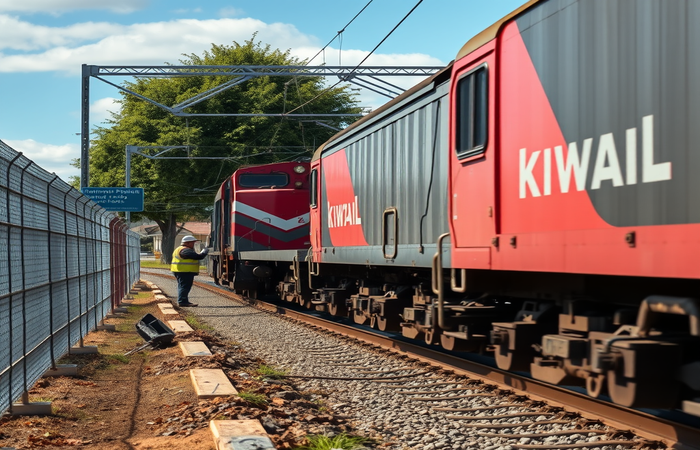Matamata Rail Safety: KiwiRail, Council Act After Tragedy

Matamata, New Zealand – October 26, 2024 – In the wake of a tragic accident involving a local high school student, KiwiRail and the Matamata-Piako District Council are taking proactive measures to enhance safety along the rail corridor in Matamata. The initiative focuses on improving visibility for train operators and preventing unauthorized access to the railway lines. This article explores the specific actions being taken, the rationale behind them, and the broader implications for railway safety in residential areas. The core of the project involves vegetation management and the implementation of fencing, which represents a multifaceted approach to mitigate risks associated with train operations in urban environments. This follows the tragic death of local high school student Sarie Morton, who was struck by a train outside her school in March. This incident has highlighted the urgent need for enhanced safety protocols and infrastructure improvements, prompting a collaborative effort between KiwiRail and the local council.
Enhancing Visibility: Vegetation Management
The primary focus of the safety enhancement project centers on improving visibility along the rail line, especially in areas with significant obstructions. This involves comprehensive vegetation management, including the removal of certain trees and the trimming of others. Specifically, more than 70 trees were identified as impediments to clear sightlines for train drivers, especially anyone approaching the rail line adjacent to Firth Street. Eleven trees are being completely removed, while the remaining trees will undergo branch lifting and canopy trimming. The aim is to ensure locomotive engineers (train drivers) have an unobstructed view of the tracks and surrounding areas, allowing them to detect potential hazards, like pedestrians, or other obstructions, with greater ease and at a greater distance. Furthermore, vegetation along the embankment next to Swap Park will also be removed. This proactive approach aligns with best practices in railway safety, which prioritize clear sightlines to minimize the risk of accidents.
Operational Considerations: Timetables and Speed Restrictions
Following the tragic incident, there were calls for operational adjustments, such as reducing train speeds or temporarily suspending services during peak hours. However, KiwiRail (New Zealand’s state-owned railway company) has emphasized the operational constraints associated with such measures. Freight trains operate according to fixed timetables and often travel long distances, necessitating efficient and reliable schedules. The Acting Chief Operations Officer of KiwiRail, Paul Ashton, has stated that, even at the existing speed limit of 70 km/h through Matamata, the considerable weight of freight trains means they cannot stop quickly, even with emergency braking. The potential for such adjustments to impact freight movements and customer service, along with the inherent challenges of slowing or suspending services in residential areas, led to the decision to focus on infrastructural improvements.
Preventing Unauthorized Access: Fencing and Access Management
Alongside vegetation management, the project includes the installation of new fencing to deter unauthorized access to the rail corridor. The Matamata-Piako District Council and KiwiRail are working to install fencing along the western side of the rail corridor (Firth Street), between the Tainui Street and Burwood Road level crossings. This is a key component in preventing trespassing and ensuring that people only cross the tracks at designated pedestrian level crossings. Additionally, the council is evaluating additional fencing and alternative access points on the eastern side of the tracks, to the official pedestrian level crossing at Tainui St, further strengthening the safety measures. These actions are designed to enforce existing regulations and encourage safe railway practices, preventing pedestrian accidents.
Public Safety and Designated Crossings
KiwiRail and the local council are working to reinforce the importance of public safety and adherence to regulations. They are reminding residents that the only safe way to cross the railway tracks is at designated crossings. The use of designated crossings, such as the one at Tainui Street, ensures pedestrians are using areas designed with safety features, like signals and barriers. Train drivers already sound their horns when passing through this section of Matamata as an added alert. Despite these measures, it is important to acknowledge that a fully loaded freight train can take up to 1 km to come to a complete stop, highlighting the critical importance of these safety measures.
Conclusion
The safety improvements implemented by KiwiRail and the Matamata-Piako District Council in Matamata represent a comprehensive approach to mitigating railway-related risks. The actions taken reflect a commitment to preventing future incidents and ensuring the safety of the community. By removing vegetation to improve visibility, implementing speed restrictions, installing new fencing, and reinforcing the importance of using designated crossings, the project aims to reduce the likelihood of accidents and promote safer railway practices. The tragic death of Sarie Morton served as a catalyst for these initiatives, highlighting the need for proactive safety measures. The project reflects a balanced approach to railway safety, taking into consideration operational constraints while prioritizing the well-being of the community. The ongoing efforts to improve safety along the rail corridor serve as a positive example of how local authorities and railway companies can collaborate to create a safer environment for all. The success of these safety measures will depend on a combination of infrastructure upgrades, public awareness, and ongoing vigilance.
Companies summary
- KiwiRail: The state-owned railway company responsible for the operation and maintenance of the railway network in New Zealand. KiwiRail’s primary responsibilities include freight and passenger services, as well as the maintenance and infrastructure of the rail network.
- Matamata-Piako District Council: The local government body responsible for the administration and management of the Matamata-Piako district, including infrastructure, urban planning, and community services. The Council works in partnership with KiwiRail to improve railway safety in the area.



